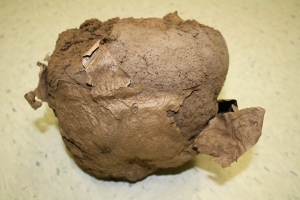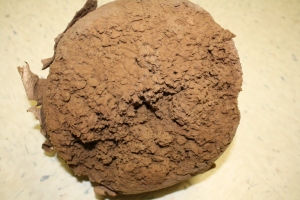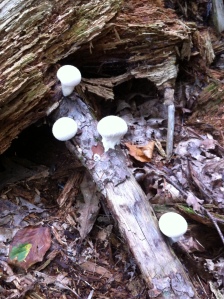Fall is the best time of year to go mushroom and fungus hunting. Among those you’ll find are different types of puffball. The fungi commonly referred to as puffballs fall mostly into three genera, Calvatia, Calbovista and Lycoperdon. When young and before spores begin to form inside, the flesh of a puffball is white and uniform, sometimes described as marshmallow-like. At this immature stage the true puffballs are edible and delicious.Puffballs range in size from smaller than a marble to larger than a basketball. The giant puffball, Calvatia gigantea, grows to anywhere from 4 to 28 inches in diameter on average but the record holder was well over eight feet across and weighed in at 48 pounds. A specimen about 10 inches in diameter contains as many as 7 trillion spores at maturity. This species occurs throughout Europe and North America and is typically found in disturbed sites with rich soil including fields, woodland edges, parks and meadows from August through September in the northeastern U.S.
- Old giant puffball, about eight inches tall, with peeling outer layer and a top view of its sponge-like appearance.
- J. Allen photos.
Before eating any puffball, make sure that’s what you have! Cut it in half to make sure the interior is solid and uniform. Some very poisonous white mushrooms resemble white puffballs when still inside their universal veil and shaped like an egg. The immature cap and gills will be visible inside when the mushroom is cut open. Only eat puffballs that are still completely white inside and out. Once they begin to turn color and produce spores, they become less tasty and, more importantly, toxic.
Okay, so how do you cook puffballs? In many cases they can be cooked or used in dishes just like edible mushrooms. They’re great sautéed in butter with a bit of seasoning, or cut up into strips or chunks and breaded and pan-fried. A few great recipes are available at the puffball page of the Mycological Society of San Francisco.
Another common puffball in the northeast is the pear-shaped puffball or stump puffball, Lycoperdon pyriforme (pyriforme is Latin for ‘pear-shaped’). Unlike most puffballs, this species is found on rotting wood of both conifers and deciduous trees instead of directly on the ground. It was first described officially by Jacob Christian Schaeffer in 1774. It’s often pear shaped (upside down pear) but can be pretty nearly spherical. Young specimens are covered in small spines that are mostly lost by maturity. As the puffballs mature, a pore forms at the top, rupturing and allowing the spores to be released and dispersed by wind and rain. These puffballs are attached to their decaying woody substrate by rhizomorphs, thick fungal strands.
- Lycoperdon pyriforme on a dead tree limb, September 2013, Connecticut. J. Allen photo.
More cooking tips: Don’t wash puffballs in water; they apparently soak up water like a sponge and get soggy. Peel off the outside skin if tough or dirty. Fresh puffballs will store well in the fridge for 2-5 days. Preserve by precooking (sautéing) and then freezing. Again, never eat mushrooms or fungi from the wild unless you are 200% sure you have identified it correctly.
Don’t forget the fun of mature puffballs if you’re too late to the woods or field and they’re all past the point of edibility! It’s fun to stomp on them and watch the smoky looking clouds of spores puff out. And this doesn’t hurt them a bit; you’re helping disperse the spores for the next generation.
Submitted by: Joan Allen


